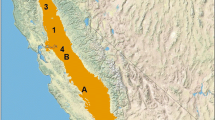Abstract
Groundwater monitoring networks were derived for 15 alternative compliance boundaries, located from 10 to 150 meters downgradient of a landfill. For each compliance boundary, a mass transport model was used to define the linear monitoring transect, perpendicular to groundwater flow, requiring the fewest detection wells. The distance (dt) to the optimal monitoring transect was consistently 0.40 to 0.75 times the distance to the compliance boundary (dc). Compliance boundaries located near a landfill provide capability for early detection, but also require a substantial number of closely spaced wells. As dc increases, the minimum number of wells (No) required along the optimal transect decreases. However, the rate of decrease (No/dc) is progressively smaller in the downgradient direction. And there is a value for dc, in this example 70 meters, beyond which the decrease in No is negligible.
Similar content being viewed by others
References
Beljin, M. S.: 1993, Solute: A Program Package of Analytical Models for Solute Transport in Ground Water, International Ground Water Modeling Center, Golden, CO.
Ben-Jemaa, F., Marino, M. and Loaiciga, H. A.: 1994, ‘Multivariate geostatistical design of groundwater monitoring networks’, Journal of Water Resources Planning and Management 120(4), 505–522.
Domenico, P. A. and Palciauskas, V. V.: 1982, ‘Alternative boundaries in solid waste management’, Ground Water 20(3), 303–311.
Environmental Protection Agency (EPA): 1994, RCRA Ground Water Monitoring: Draft Technical Guidance. Government Institutes, Rockville, MD.
Federal Register: 1991, 56(196), 51021.
Hsueh, Y. W. and Rajagopal, R.: 1988, ‘Modeling ground-water quality decisions’, Ground-Water Monitoring Review, 8(4), 121–134.
Hudak, P. F.: 1994, ‘A method for monitoring groundwater quality near waste storage facilities’, Environmental Monitoring and Assessment 30, 197–210.
Hudak, P. F. and Loaiciga, H. A.: 1992, ‘A location modeling approach for groundwater monitoring network augmentation’, Water Resources Research 28(3), 643–649.
Loaiciga, H. A.: 1989, ‘An optimization approach for ground-water quality monitoring network design’, Water Resources Research 25(8), 1771–1780.
Meyer, P. D. and Brill, E. D.: 1988, ‘A method for locating wells in a groundwater monitoring network under conditions of uncertainty’, Water Resources Research 24(8), 1277–1282.
Meyer, P. D., Valocchi, A. J. and Eheart, J. W.: 1994, ‘Monitoring network design to provide initial detection of groundwater contamination’, Water Resources Research 30(9), 2647–2659.
Parkhurst, D. F.: 1984, ‘Optimal sampling geometry for hazardous waste sites’, Environmental Science and Technology 18(7), 521–523.
Rouhani, S.: 1985, ‘Variance reduction analysis’, Water Resources Research 21(6), 837–846.
Spruill, T. B. and Candela, L.: 1990, ‘Two approaches to design of monitoring networks’, Ground Water 28(3), 430–442.
Wilson, C. R., Einberger, C. M., Jackson, R. L. and Mercer, R. B.: 1992, ‘Design of ground-water monitoring networks using the monitoring efficiency model (MEMO)’, Ground Water 30(6), 965–970.
Author information
Authors and Affiliations
Rights and permissions
About this article
Cite this article
Hudak, P.F. Effects of compliance boundary location on contaminant detection networks in aquifers. Environ Monit Assess 43, 217–225 (1996). https://doi.org/10.1007/BF00394450
Issue Date:
DOI: https://doi.org/10.1007/BF00394450




